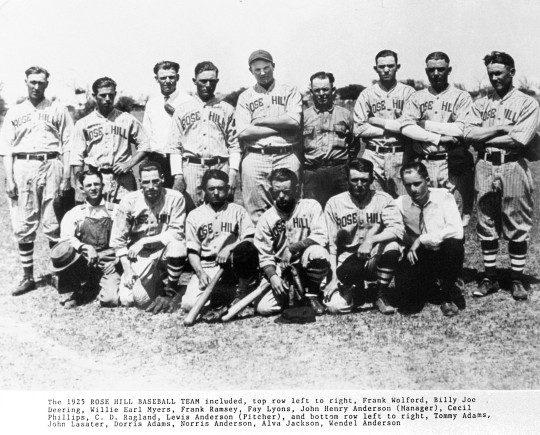This article originally appeared in the Garland/Mesquite section of The Dallas Morning News on August 4, 1995.
By Michael R. Hayslip
The Rose Hill baseball team of the 1920s needed no mascot name; “Rose Hill” was distinguished enough for a tough bunch of country boys, ranging in age from 19 to 26, who were determined to play and play hard. Since there was no formal league or official sponsor for the group, it was technically an amateur or community team, but the players were plenty serious about it.
Fay Lyons, an 88-year-old retired petroleum distributor who is so far as anybody knows the oldest and the only living graduate of the program, tells it this way:
“Most of the boys worked all week in the fields, so they needed some clean recreation. I had packed up and left the family farm for a job in Dallas, but I came back on the weekends to play ball with the fellas I knew. Folks who didn’t play just liked to watch”.
“Back in the ‘20s the only respectable activity in Rose Hill on a summer Sunday afternoon was baseball,” claims Ms. Selma Swaffer Anderson, whose late husband Wendel “Pedlo” Anderson played catcher on the team.
When they watched a home game in Rose Hill, fans did it without bleachers. Crowds ranging from 50 to 400 would stand, sit on the ground or observe from cars, which were parked behind home plate or along the first-base line. Usually, some enterprising individual sold refreshments. On occasion, an out-of-town game meant bleachers.
Rose Hill home games were played on land furnished by Henry Anderson on the west side of Rose Hill Road at the present I-30. Sand, grading and fence repair were provided by volunteers. One umpire stood behind the pitcher’s mound and another at first base. A gate keeper tried to collect 50 cents to a dollar a head from fans for a pot to be split 60/40 in favor of the winning team, but latecomers were liable to miss the collection.
The whole team seemed to function by consensus. John Henry Anderson held the managers title, but Lyons indicated that he and several of the players assisted. “Since I’d been around there for three generations, I knew the guys from other teams in the area, and I arranged games with teams like Garland, New Hope (now Sunnyvale), Reinhardt, Sachse and Wylie.”
“Our boys,” Lyons added, “were drafted by general agreement as needed. I was living in Dallas, and Cecil Phillips, a pitcher, came from Heath. Elmer Dean, Dizzy’s younger brother from Garland, had a good curve ball and pitched a couple of games for us. Everybody on the team knew what was needed and which ones were carrying their shares.”
The team photo was taken in 1925, the year that Washington defeated New York 4-3 in the 21st World Series, and Calvin Coolidge was beginning his second term as president. In Rose Hill the summer was no hotter than usual, but rainfall was a third less than normal, so there was plenty of dust on the ball field.
For the 1925 season The Garland News made weekly reports on the team in its regular Rose Hill news feature, appropriately listing ball scores just after Sunday School attendance and summer revival results. The front page of the paper was reserved for Garland athletes and the Scopes Monkey Trial, which occurred the same summer.
Aside from the fact that team player Norris Anderson broke a rib, Rose Hill finished that season with a .636, winning seven games over the MWA team, Plano, Richardson, Rowlett, Woodmen of the World/Dallas, and Wylie. They also lost games to Rowlett and Wylie, as well as to Irving and the Dallas team sponsored by Sam Dysterbach, a clothing and dry goods merchant located near the old red courthouse.
Besides Lyons, who played first base and catcher, the regulars at the time also included Lewis Anderson, pitcher with a fast-breaking curve ball; Norris Anderson, second base; Alva Jackson, center field; C. D. Ragland, shortstop; and Frank Ramsey, right field. Norris Anderson, Lyons and Frank Wolford were among the top hitters.
One of the local fans, Clarence Pike, still lives near the old field site in Rose Hill and recalls the day the team picture was taken. He was 10 years old at the time and kept following the team until he left town to enter military service. “When I got back home in 1939,” says Pike, “Rose Hill still had a good team on the field. I guess the war finished it.”
Lyons remembers that Garland had a good team in the ‘20s as well, with W. L. Grubb and Howard Shugart as steady players. Cecil Cooper and J. T. McCallum were Garland’s co-captains in 1925, and their home games were played on the field by the old Cotton Oil Mill site, near the current Garland main post office.
Rowlett also fielded a crackerjack team in those days. Wylie Sharp managed the team, and reports circulated that he hired some of his best players.
Following his Rose Hill experience Lyons moved on to the Fair Park Panthers team in Dallas, where he played for several more years. A few of his teammates there were ex-Texas Leaguers, who had hit a slump or pulled too hard on the bottle. Some, like Dizzy Dean’s other brother, Paul, were on their way up.
Lyons says that he and Norris Anderson of the old Rose Hill team were later scouted and offered contracts with the St. Louis Cardinals, but declined for fear of being lost on a farm team in the shuffle. That meant that the only game he actually got to play with Dizzy Dean himself was one that eventually occurred when they “slud in” together at a poker table. And like most of his other games, Fay Lyons is the only one left to tell about it.
Photo caption:The Rose Hill baseball team of 1925.
Photo courtesy Fay Lyons.


